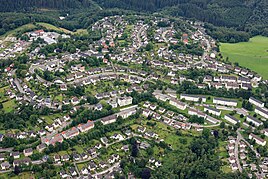Löh (Schalksmühle)
|
Löh
Schalksmühle municipality
Coordinates: 51 ° 14 ′ 12 ″ N , 7 ° 31 ′ 22 ″ E
|
||
|---|---|---|
| Height : | 244 m above sea level NN | |
| Postal code : | 58579 | |
|
Location of Löh in Schalksmühle |
||
|
The district of Mathagen with Löh (upper left corner)
|
||
Löh is a district of Schalksmühle in the Märkisches Kreis in the administrative district of Arnsberg in North Rhine-Westphalia ( Germany ). The original Löh farm was demolished in the 1960s and the Schalksmühl school center built over it.
Location and description
Löh is located southwest of the core town on the western slope of the Hälvertal on the edge of the larger district of Mathagen , with which it has grown together. Other neighboring towns are next to the nucleus minor Siepen , Rotthausen , on New House , Herbecke , On Altenhammer , Hälver , rocker cooling and the Volme away Klagebach , hut , New Bridge and Flaßkamp .
history
Löh, which belongs to the parish of Halver , was first mentioned in 1557, but the time of origin of the settlement is assumed to be between 1050 and 1200 as a result of the clearing phase after the high medieval territorial formation. Löh is a split from Rotthausen.
In 1818 15 people lived in the village. In 1838 Loeh belonged to the Gloerfeld peasantry within the Halver mayor . The place, which was categorized as a courtyard according to the location and distance table of the government district of Arnsberg , had six residential buildings, a factory or mill and four agricultural buildings at that time. At that time, 27 residents lived in the village, all of whom were Protestant.
The place is recorded as Löh on the Prussian first recording from 1840 . From the Prussian new admission in 1892, the location is recorded on the TK25 measuring table as Löh .
The municipality and estate district statistics of the province of Westphalia in 1871 listed the place as a farm with five houses and 32 inhabitants. The municipality encyclopedia for the province of Westphalia in 1885 gives a number of 35 inhabitants for Löh who lived in six houses. In 1895 the place had five houses with 40 inhabitants and belonged to the Protestant parish Schalksmühle, in 1905 the place had six houses and 33 inhabitants.
On October 1, 1912, the area around the place was spun off from the municipality of Halver and assigned to the newly founded municipality of Schalksmühle.
In the 1960s the yard was demolished in order to build a school center.
Individual evidence
- ^ Alfred Jung: Halver and Schalksmühle. Investigation and thoughts on the settlement history of the Halver Office, an old parish in the Saxon-Franconian border area. Friends of Altena Castle, Altena 1978 ( Altenaer contributions. Works on the history and local history of the former county Mark 13, ISSN 0516-8260 ).
- ↑ Johann Georg von Viebahn : Local and distance table of the government district Arnsberg, arranged according to the existing state division, with details of the earlier areas and offices, the parish and school districts and topographical information. Ritter, Arnsberg 1841.
- ↑ Royal Statistical Bureau Prussia (ed.): The communities and manor districts of the Prussian state and their population . The Province of Westphalia, No. IX . Berlin 1874.
- ↑ Royal Statistical Bureau (Prussia) (ed.): Community encyclopedia for the province of Westphalia, based on the materials of the census of December 1, 1885 and other official sources, (community encyclopedia for the Kingdom of Prussia, Volume X), Berlin 1887.
- ↑ Königliches Statistisches Bureau (Prussia) (Ed.): Community encyclopedia for the province of Westphalia, based on the materials of the census of December 1, 1895 and other official sources, (community encyclopedia for the Kingdom of Prussia, Volume X), Berlin 1897.
- ↑ Königliches Statistisches Bureau (Prussia) (Ed.): Community encyclopedia for the province of Westphalia, based on the materials of the census of December 1, 1905 and other official sources, (community encyclopedia for the Kingdom of Prussia, Volume X), Berlin 1909.


